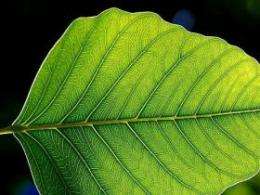Inspired by water transport in natural leaves (shown), researchers have created a synthetic, microfabricated "leaf" that can generate power from evaporative flow. Image credit: pdphoto.org
Finnish researchers have demonstrated that photoinhibition of photosystem I, which reduces the effectiveness of photosynthesis, is actually a plant's self-defense mechanism against more extensive harm. The research was funded by the Academy of Finland.
Plants use energy from the Sun to convert carbon dioxide and water into carbohydrates that act as the building blocks and energy sources for life. Oxygen is produced as a by-product of photosynthesis. However, this also causes secondary reactions that slow photosynthesis.
"Photosynthesis has developed in conditions where the atmosphere's oxygen content was low and its carbon dioxide content high. When photosynthetic organisms became the dominant life form around the world, the atmosphere's oxygen content rose, after which its secondary reactions have become a problem for photosynthesis," says University Lecturer of Molecular Plant Biology Mikko Tikkanen from the University of Turku. Tikkanen also works in the Academy of Finland's Centre of Excellence in Molecular Biology of Primary Producers.
Despite having developed safety mechanisms against secondary reactions, plants cannot avoid damage completely. An intriguing observation was that the damage alters the function of photosystem I. Instead of forwarding electrons from water splitting photosystem II, a damaged photosystem I begins to dissipate excess excitation energy as heat and stops producing NADPH molecules, which is its normal function.
"We proved that altering the function is a way to protect the photosynthetic apparatus from more extensive damage. Damage initiates a series of changes, where the direction of light energy is turned towards damaged photosystem I centres. This reduces the risk of damage to photosystem II and curtails the electron flow towards photosystem I, which stops the damage, Tikkanen explains.
In photosynthesis, photosystem II oxidises water into electrons, hydrogen protons and oxygen, whereas photosystem I uses electrons to produce high energy NADPH. The damage referred to as photoinhibition has been thought to be a detrimental reaction that should be avoided. It was thought, among other things, to reduce profits from crops.
"It was previously believed that photosystem II and photosystem I worked in series but rather independently in converting light energy into chemical form. Our new research demonstrates that photosystems form a functional pair in that damage to one protects the other from more extensive damage," Tikkanen says.
An understanding of the roles of photosynthesis' different photosystems is important with regard to understanding the evolution of the photosynthesis mechanism.
"When the roles are recognised, we will no longer use the wrong methods in an effort to increase the effectiveness of photosynthesis. New data helps us see the problem points for the development of artificial photosynthesis," Tikkanen says.
More information: Arjun Tiwari et al. Photodamage of iron–sulphur clusters in photosystem I induces non-photochemical energy dissipation, Nature Plants (2016). DOI: 10.1038/nplants.2016.35
Journal information: Nature Plants
Provided by Academy of Finland























